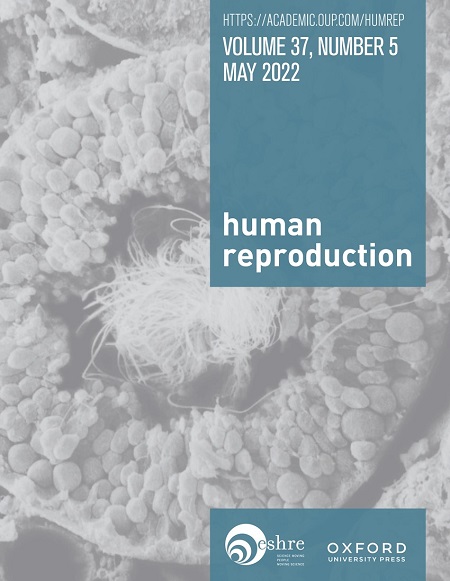Comparison of fresh testicular sperm aspiration and use of either thawed pre-frozen sperm or oocyte freezing: impact on cumulative live birth rates for couples experiencing ejaculation failure
IF 6
1区 医学
Q1 OBSTETRICS & GYNECOLOGY
引用次数: 0
Abstract
STUDY QUESTION Is there a difference in the cumulative live birth rate (CLBR) after fresh testicular sperm aspiration (TESA) compared with the use of either pre-frozen sperm or oocyte freezing for couples experiencing ejaculation failure on the day of oocyte retrieval? SUMMARY ANSWER After adjusting for confounding factors, the use of pre-frozen sperm or the freezing and thawing of oocytes appeared to be as effective as TESA in achieving CLBRs for couples experiencing temporary ejaculation failure. WHAT IS KNOWN ALREADY Male patients may be concerned about experiencing temporary ejaculation failure on the day of their partner’s oocyte retrieval, in which case they may choose surgical sperm retrieval, oocyte freezing on the day, or have their sperm frozen in advance. However, the clinical efficacy of these three options has not yet been evaluated. STUDY DESIGN, SIZE, DURATION A retrospective data analysis was conducted on 65 178 oocyte retrieval cycles at a university-affiliated IVF center from January 2012 to May 2021. PARTICIPANTS/MATERIALS, SETTING, METHODS The overall characteristics, completed cycle characteristics, and clinical outcomes were analyzed among couples with ejaculation failure who underwent three distinct clinical interventions, with those receiving TESA serving as the control group. The primary outcome measure was the CLBR, and the secondary outcome measures were the clinical pregnancy rate (CPR) and live birth rate (LBR) per embryo transfer. A robust (modified) Poisson regression model was used to evaluate the association between the three clinical options for ejaculation failure and CLBRs. MAIN RESULTS AND ROLE OF CHANCE Of the eligible oocyte retrieval cycles, 756 cycles (1.2%) experienced ejaculation failure, with 640 cycles completing treatment. These treatments included 325 cycles using TESA, 227 cycles utilizing pre-frozen sperm, and 88 cycles involving frozen–thawed oocytes. The CLBRs for the TESA, thawed-sperm and thawed-oocyte groups were 36.9%, 48.9%, and 34.1%, respectively, showing a statistically significant difference (P = 0.007). Specifically, the thawed-sperm group demonstrated a significantly higher CLBR compared to the TESA group, while no significant difference was observed between the TESA and thawed-oocyte groups. Similarly, the CPRs and LBRs per embryo transfer for the three groups were 37.4%, 50.0%, and 41.8%, respectively (P = 0.005), and 29.9%, 39.6%, and 33.0%, respectively (P = 0.030). Again, the thawed-sperm group showed a significantly higher CPR and a significantly higher LBR, but no significant differences for the thawed-oocyte group, compared to the TESA group. Notably, the significant differences in both CLBR and LBR emerged after the second embryo transfer. However, after adjusting for multiple factors, including female age at oocyte retrieval, type and duration of infertility, female body mass index, number of previous IVF cycles, ovarian stimulation protocol, endometrial thickness on the last ultrasound, insemination method, number of oocytes retrieved, number of fertilized oocytes, and number of usable embryos on Day 3, the analysis revealed no significant association between CLBR and the use of pre-frozen sperm (risk ratio (RR) 1.08, 95% confidence interval (CI) 0.81–1.44) or thawed oocytes (RR 1.01, 95% CI 0.76–1.33), compared with TESA. LIMITATIONS, REASONS FOR CAUTION Given that the study is retrospective and the sample size is too small, particularly concerning the use of thawed oocytes, we acknowledge that the data present here is only suggestive and refers to an association that warrants cautious interpretation. Therefore, further research in the form of prospective studies as well as randomized controlled trials is needed to provide a definitive answer to the research question. WIDER IMPLICATIONS OF THE FINDINGS Our findings suggest that using pre-frozen sperm or frozen-thawed oocytes can offer comparable CLBRs to TESA for cases of temporary ejaculation failure, providing clinical alternatives that may reduce the logistical challenges in ART cycles. STUDY FUNDING/COMPETING INTEREST(S) This study was supported by the National Nature Science Foundation of China (grant nos. 82101672, 82171589), the National Key Research and Development Program of China (grant nos. 2022YFC2702504, 2019YFE0109500), the Basic and Applied Basic Research Foundation of Guangdong Province (grant no. 2021A1515010774), and the Guangzhou Municipal Science and Technology Project (grant nos. 202102010075, 2023A4J0578). The authors declare that they have no conflict of interest in relation to the data in this paper. TRIAL REGISTRATION NUMBER N/A新鲜睾丸精子抽吸与解冻预冻精子或卵母细胞冷冻的比较:对经历射精失败的夫妇的累计活产率的影响
研究问题:对于在取卵当天出现射精失败的夫妇,新鲜睾丸精子抽吸(TESA)后的累积活产率(CLBR)与使用预冻精子或卵母细胞冷冻相比是否有差异?在对混杂因素进行调整后,对于经历暂时性射精失败的夫妇来说,使用预冻精子或卵母细胞的冷冻和解冻似乎与TESA一样有效。男性患者可能会担心在其伴侣取卵当天出现暂时性射精失败,在这种情况下,他们可以选择手术取精、当天冷冻卵母细胞或提前冷冻精子。然而,这三种方案的临床疗效尚未得到评价。研究设计、规模、持续时间回顾性分析了2012年1月至2021年5月在某大学附属试管婴儿中心进行的65178个卵母细胞回收周期的数据。参与者/材料、环境、方法对接受三种不同临床干预的射精失败夫妇的总体特征、完成周期特征和临床结果进行分析,接受TESA治疗的夫妇作为对照组。主要指标是CLBR,次要指标是临床妊娠率(CPR)和每次胚胎移植的活产率(LBR)。一个稳健的(修正的)泊松回归模型被用来评估射精失败的三种临床选择与clbr之间的关系。在符合条件的取卵周期中,756个周期(1.2%)出现射精失败,640个周期完成治疗。这些治疗包括325个周期使用TESA, 227个周期使用预冻精子,88个周期使用冻融卵母细胞。TESA组、解冻精子组和解冻卵母细胞组的clbr分别为36.9%、48.9%和34.1%,差异有统计学意义(P = 0.007)。具体来说,与TESA组相比,解冻精子组的CLBR明显更高,而TESA组和解冻卵母细胞组之间没有显著差异。3组每次胚胎移植的cpr和lbr分别为37.4%、50.0%和41.8% (P = 0.005), 29.9%、39.6%和33.0% (P = 0.030)。再一次,与TESA组相比,解冻精子组的CPR和LBR明显更高,但解冻卵母细胞组没有显著差异。值得注意的是,CLBR和LBR在第二次胚胎移植后出现了显著差异。然而,在调整了多种因素后,包括女性取卵时的年龄、不孕症的类型和持续时间、女性体重指数、既往IVF周期次数、卵巢刺激方案、最后一次超声子宫内膜厚度、人工授精方式、取卵数、受精卵数、第3天可用胚胎数,分析显示CLBR与使用预冻精子之间无显著相关性(风险比(RR) 1.08)。95%可信区间(CI) 0.81-1.44)或解冻卵母细胞(RR 1.01, 95% CI 0.76-1.33)。鉴于该研究是回顾性的,样本量太小,特别是涉及到解冻卵母细胞的使用,我们承认这里的数据只是暗示性的,并且涉及到一种需要谨慎解释的关联。因此,需要以前瞻性研究和随机对照试验的形式进行进一步的研究,以提供研究问题的明确答案。研究结果的更广泛意义我们的研究结果表明,对于暂时性射精失败的病例,使用预冻精子或冷冻解冻卵母细胞可以提供与TESA相当的clbr,提供临床替代方案,可能减少ART周期中的后勤挑战。研究经费/竞争利益(S)本研究由国家自然科学基金(批准号:82101672、82171589)、国家重点研究发展计划(批准号:2022YFC2702504、2019YFE0109500)、广东省基础与应用基础研究基金(批准号:2020yfc2702504、2019YFE0109500)资助。2021A1515010774),广州市科技计划项目(资助号:202102010075、2023A4J0578)。作者声明他们与本文中的数据没有利益冲突。试验注册号n / a
本文章由计算机程序翻译,如有差异,请以英文原文为准。
求助全文
约1分钟内获得全文
求助全文
来源期刊

Human reproduction
医学-妇产科学
CiteScore
10.90
自引率
6.60%
发文量
1369
审稿时长
1 months
期刊介绍:
Human Reproduction features full-length, peer-reviewed papers reporting original research, concise clinical case reports, as well as opinions and debates on topical issues.
Papers published cover the clinical science and medical aspects of reproductive physiology, pathology and endocrinology; including andrology, gonad function, gametogenesis, fertilization, embryo development, implantation, early pregnancy, genetics, genetic diagnosis, oncology, infectious disease, surgery, contraception, infertility treatment, psychology, ethics and social issues.
 求助内容:
求助内容: 应助结果提醒方式:
应助结果提醒方式:


